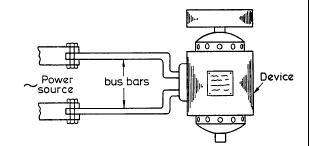go to WEEK 4 Problem 1 2 3 4 5 Online Course Support
MSE 5090: Case Studies in Material Selection
Week 4 - Cambridge Material Selector1
Problem 1.4
A busbar is the element of an electrical circuit which delivers the current from the input source to the device which consumes it (Figure 1.3). The flex of your toaster is a busbar, though one of low current-carrying capacity. Devices which consume large currents require massive busbars to minimize the electrical losses external to the machine itself. Specialized databases: busbars
The current-carrying capacity of a busbar is limited by temperature rise and this, for a given current, scales as the resistivity, Pe. Busbars often span large spaces, so they must be strong enough to support their own weight plus any accidental loads imposed on them. Thus we seek materials with low values of resistivity Pe coupled with high values of the elastic limit (yield strength) se1; more exactly, we seek materials with high values of the index

Create a chart with axes of se1 and Pe. Use a box selection to find materials that have high values of M1, emphasizing low resistivity since strength can be coped with by adding supports. Various copper alloys should feature in your selection. Change to the Conductors database (a specialized database of materials which find application as electrical conductors), leaving the axes and selection box where it is. Now move the box to identify the best materials for the job.
Figure 1.3 Busbars transmit electrical power from the power source to the device which consumes it.
1. Ashby, M. and D. Cebon, Exercises in the Use of CMS 2.0, Granta Design, Cambridge UK, 1995, 9. 

Last update 9-20-98
